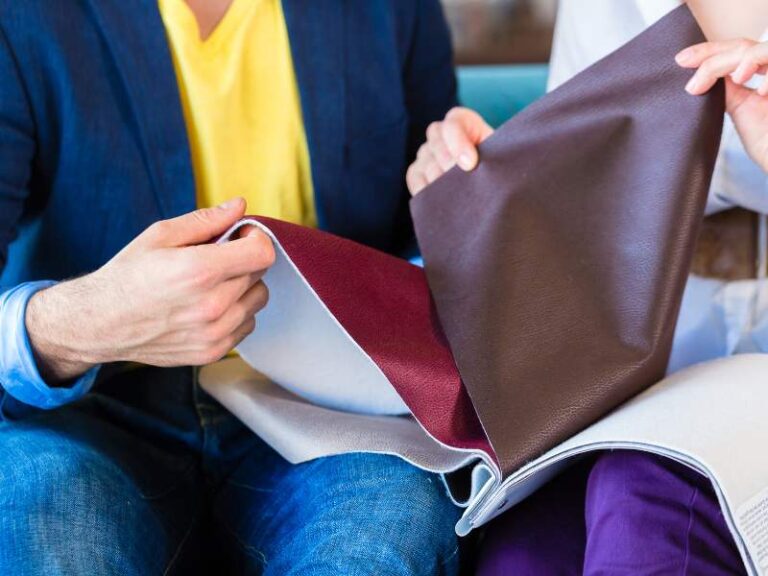Which Material is Good for Seat Covers? Discover the Ultimate Guide!
Leather is a good material for seat covers due to its durability and aesthetic appeal. It provides a sleek and stylish look to the seats while also being resistant to wear and tear.
Additionally, leather seat covers are easy to clean and maintain, making them a popular choice for car owners. With their natural breathability, leather seat covers offer a comfortable seating experience, especially during hot weather. The high-quality leather used in seat covers ensures longevity, saving you from the hassle of frequent replacements.
Whether it’s for a car, a boat, or even a motorcycle, leather seat covers add a touch of luxury and sophistication to any vehicle.
Ultimate Guide To Seat Cover Materials
The choice of material for your seat covers is crucial as it not only affects the overall look and feel of your vehicle’s interior but also impacts your comfort and durability. Choosing the right material is essential to ensure maximum protection and aesthetic appeal. Here are some important factors to consider before purchasing seat covers:
- Comfort: The material should provide a comfortable seating experience, with the right level of softness and breathability.
- Durability: Opt for materials that are resistant to wear and tear, such as high-quality leather or durable fabrics.
- Protection: The seat covers should protect your original seats from spills, stains, and damage caused by regular usage.
- Easy maintenance: Consider materials that are easy to clean and maintain, allowing you to keep your seat covers in good condition.
- Style: Different materials offer varying aesthetics, so choose one that complements the interior design of your vehicle.
Usage
Assess your lifestyle and the purpose of your vehicle to determine the right material. For example, if you frequently transport pets or children, opt for stain-resistant materials.
Climatic Conditions
Consider the climate in your area. Materials such as neoprene are suitable for hot and humid environments, while leather offers durability in colder climates.
Budget
Determine your budget and explore materials that fit within your financial range. Remember to balance cost with quality.
Customization
If you prefer a personalized touch, look for materials that can be tailored to fit your vehicle’s specific measurements.
Reviews and recommendations: Research customer reviews and seek recommendations from trusted sources to gain insights into the durability and performance of different seat cover materials.
Durability And Protection
Seat covers play a crucial role in protecting your car’s seats from wear and tear. When choosing the right material for your seat covers, it’s important to consider their resistance to wear and tear. Opt for materials such as neoprene or leather which are known for their durability and ability to withstand daily use and abuse. These materials are resistant to tearing, fraying, and fading, ensuring long-lasting seat covers.
Resistance To Wear And Tear
Neoprene is a popular choice for seat covers due to its excellent resistance to wear and tear. It is a synthetic material that is not only durable but also waterproof, making it ideal for those who often experience spills or have pets in the car. On the other hand, leather is another durable option that not only offers resistance to wear and tear but also provides a luxurious look and feel.
Waterproof Vs. Water-resistant
When it comes to protecting your seats from liquid spills, it’s important to understand the difference between waterproof and water-resistant materials. Waterproof materials such as neoprene act as a barrier, preventing any liquid from seeping through to the seat. On the other hand, water-resistant materials like certain types of fabric have a coating that repels water, but they may not be completely impervious to liquid penetration.
Uv And Stain Protection
In addition to wear and tear, seat covers should also provide protection against UV rays and stains. Look for materials that offer UV protection to prevent fading and cracking caused by sun exposure. Some materials are also treated to be stain-resistant, making it easier to clean up spills and prevent permanent stains.
Comfort And Style
For seat covers that combine comfort and style, look for materials like leather, suede, or neoprene. These options not only offer a luxurious feel, but also provide durability and easy maintenance for your car seats. Keep your style preferences and practicality in mind when choosing the perfect material.
| Subheading | Summary |
|---|---|
| Breathability and Temperature Regulation | Materials like cotton and linen are highly breathable, allowing air to flow and prevent sweating. They provide a comfortable seating experience, especially during hot weather conditions. |
| Texture and Touch | Leather seat covers offer a luxurious feel and smooth texture. They are soft and supple, providing a premium touch to your car seats. Alternatively, microfiber fabrics are also popular, offering a velvety texture and a comfortable tactile experience. |
| Aesthetic Appeal and Personalization Options | Seat covers made of neoprene provide a sporty and modern look to your car interior. They are available in various color options, allowing you to personalize and enhance the overall aesthetic appeal of your vehicle. |
Maintenance And Care
Seat covers made from high-quality materials like leather, fabric or neoprene are recommended for easy maintenance and long-lasting care. Their durability and resistance to stains and spills make them a great choice for protecting car seats.
When choosing seat covers, it is important to consider the ease of cleaning. Seat covers made of materials like neoprene, vinyl, or leatherette are known for their ability to resist stains and spills, making them easy to clean with just a damp cloth or sponge. These materials are also resistant to fading and can withstand regular use without showing signs of wear and tear. On the other hand, fabric seat covers may require more frequent care and cleaning, as they can easily absorb liquid spills and stains. Despite this, fabric seat covers often offer a wider variety of styles and colors to choose from, allowing you to customize your car’s interior.
Ease of Cleaning
Seat covers made of neoprene, vinyl, or leatherette can be easily cleaned with a damp cloth or sponge. This makes them ideal for individuals who are looking for low-maintenance options or have a busy lifestyle. Fabric seat covers, on the other hand, may require more frequent cleaning, as they can absorb spills and stains. Regular vacuuming and spot cleaning can help keep fabric seat covers looking their best.
Frequency of Care Needed
If you opt for neoprene, vinyl, or leatherette seat covers, you will not need to clean them as frequently as fabric seat covers. These materials are resistant to stains and spills, reducing the need for regular cleaning. However, it is still important to wipe them down periodically to remove dirt and dust.
Fabric seat covers, on the other hand, may require more regular care and attention, especially if they are exposed to spills or heavy use on a daily basis. Regular vacuuming and spot cleaning can help prolong the lifespan of fabric seat covers and keep them looking fresh.
Long-Term Value and Upkeep
When considering the long-term value and upkeep of seat covers, neoprene, vinyl, or leatherette options often come out on top. These materials are durable and resistant to fading, providing long-lasting protection for your car seats. They can also be easily wiped clean, reducing the need for frequent washing or dry cleaning.
Fabric seat covers, while they may require more regular care, can still offer value and a stylish look to your car’s interior. However, it is important to keep in mind that fabric seat covers may show signs of wear and tear over time and may need to be replaced more frequently than their synthetic counterparts.
Choosing The Right Material For Your Needs
When selecting seat covers for your vehicle, it’s essential to consider the right material based on your needs. The choice depends on several factors, such as the type of vehicle and its usage, the climate and environment where you live, and your budget and preferences in terms of cost-effectiveness.
Vehicle Type and Usage
For everyday use vehicles, durable materials like neoprene, vinyl, or synthetic leather are suitable options. They offer resistance against stains, spills, and general wear and tear. If you have a luxury car, genuine leather seat covers provide a sophisticated look.
Climate and Environment
In hot climates, seat covers made of breathable materials like mesh or cotton blends help to keep you cool and prevent excessive sweating. For cold weather regions, materials with insulation properties such as sheepskin or faux fur can provide warmth and comfort.
Budget and Cost-Effectiveness
If you’re on a tight budget, seat covers made of polyester or nylon offer a cost-effective option while still providing decent protection. They are easy to clean and maintain, making them a practical choice for daily use vehicles.
Impact On Health And Environment
In today’s environmentally conscious world, choosing the right material for seat covers is essential to promoting both health and sustainability. Opting for hypoallergenic seat covers can significantly improve the well-being of individuals who suffer from allergies or sensitivities. These covers are made from materials that are less likely to trigger allergic reactions, making them a practical choice for those with sensitive skin or respiratory conditions.
When considering the environmental impact, it’s vital to select seat covers made from eco-friendly materials. Some popular options include organic cotton, hemp, or bamboo, which are naturally sustainable and biodegradable. These materials not only reduce reliance on harmful chemicals and pesticides but also minimize waste and pollution during the production process.
| Safety Standards and Regulations |
|---|
| When purchasing seat covers, it’s important to ensure they meet appropriate safety standards and regulations. Look for covers that have undergone rigorous testing and certification to ensure they offer adequate protection in the event of an accident. Meeting safety standards guarantees the covers are designed to uphold the highest level of safety for passengers while driving. |
Innovations And Trends In Seat Cover Material
Seat cover materials have come a long way in recent years, with the latest technological advancements paving the way for innovative options. Popularity and consumer preferences play a significant role in shaping the trends in this industry. Manufacturers are constantly striving to meet the evolving demands of customers, offering a wide range of choices. The materials used for seat covers today are more durable and versatile than ever before.
They are designed to provide comfort, protection, and a sleek appearance. From leather to neoprene, there is a material to suit every need and style. Some of the latest technological advancements in seat cover materials include waterproof and stain-resistant fabrics, advanced stitching techniques, and innovative designs. Consumer preferences are driving the demand for seat covers that offer enhanced features and functionality. With the rise of eco-consciousness, eco-friendly materials are gaining popularity.
Customers also look for materials that are easy to clean and maintain, as well as ones that provide maximum comfort during long drives. Looking ahead, the future of seat cover material development looks promising. Manufacturers are constantly researching and experimenting with new materials and technologies to cater to the evolving needs of customers.
The focus is on creating seat covers that are not only functional but also visually appealing. With advancements in textile technology, we can expect to see more durable, moisture-wicking, and customizable seat cover options in the future.
Frequently Asked Questions For Which Material Is Good For Seat Covers?
What Are The Benefits Of Using Seat Covers?
Seat covers offer protection from spills, stains, and wear and tear. They can also enhance the aesthetic appeal of your vehicle’s interior, provide comfort, and increase the resale value of your car.
Which Material Is Best For Seat Covers?
There are various materials available for seat covers, each with its own benefits. Popular options include leather for a luxurious look, neoprene for water resistance and durability, and polyester for affordability and easy maintenance. Consider your needs and preferences before choosing the material.
How Do I Choose The Right Seat Cover Material?
When choosing a seat cover material, consider factors like durability, comfort, ease of cleaning, and compatibility with your vehicle’s interior. It’s also important to consider your budget and personal preferences in terms of style and appearance.
Are Seat Covers Easy To Install And Remove?
Yes, most seat covers are designed for easy installation and removal. They usually come with elastic straps, hooks, or clips that secure them in place. Make sure to follow the manufacturer’s instructions for a hassle-free installation process.
Conclusion
Choosing the right material for your seat covers is crucial for ensuring comfort, durability, and style. Whether you opt for leather for a luxurious feel, neoprene for waterproof protection, or cotton for breathability, it’s important to consider your specific needs and preferences.
By understanding the benefits and features of each material, you can make an informed decision that will enhance the look and functionality of your vehicle’s interior. Shop around and explore different options to find the perfect seat covers that suit your style and provide the desired level of comfort and protection you need.
- Can I Get in a Taxi Without a Car Seat? - January 26, 2025
- Can I Get Chlamydia From a Toilet Seat? - January 26, 2025
- Can I Get an Uber With a Car Seat? - January 26, 2025






